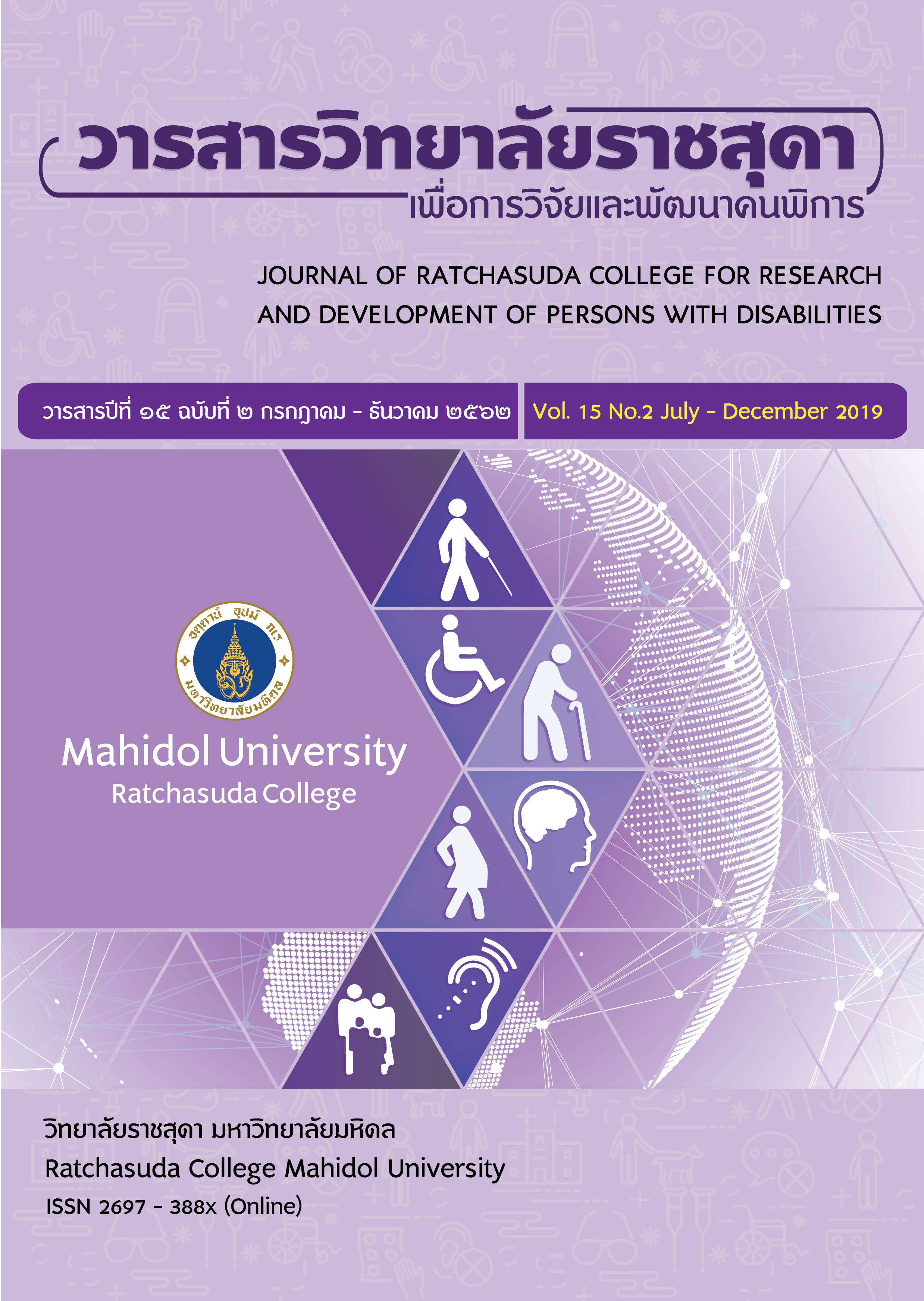ผลของดนตรีบำบัดที่มีต่อการฟื้นฟูการพูดในคนหูตึง วัยผู้ใหญ่ตอนต้น
คำสำคัญ:
ดนตรีบำบัด, การพูด, คนหูตึงวัยผู้ใหญ่ตอนต้นบทคัดย่อ
การวิจัยครั้งนี้มีวัตถุประสงค์เพื่อศึกษาผลของดนตรีบำบัดที่มีต่อการฟื้นฟูการพูดในคนหูตึงวัยผู้ใหญ่ตอนต้น โดยใช้วิธีวิจัยเชิงทดลองแบบการวัดซ้ำ ร่วมกับวิธีวิจัยเชิงคุณภาพ ผู้เข้าร่วมการวิจัย คือ นักศึกษาที่มีความบกพร่องทางการได้ยิน ระดับปริญญาตรี วิทยาลัยราชสุดา มหาวิทยาลัยมหิดล จำนวน 9 คน โดยเข้าร่วมการทดลองกิจกรรมดนตรีบำบัดแบบกลุ่ม จำนวนทั้งหมด 10 ครั้ง สัปดาห์ละ 2 ครั้ง ครั้งละหนึ่งชั่วโมง มีกิจกรรมดนตรีบำบัดดังต่อไปนี้ การวิจัยครั้งนี้มีวัตถุประสงค์เพื่อศึกษาผลของดนตรีบำบัดที่มีต่อการฟื้นฟูการพูดในคนหูตึงวัยผู้ใหญ่ตอนต้น โดยใช้วิธีวิจัยเชิงทดลองแบบการวัดซ้ำ ร่วมกับวิธีวิจัยเชิงคุณภาพ ผู้เข้าร่วมการวิจัย คือ นักศึกษาที่มีความบกพร่องทางการได้ยิน ระดับปริญญาตรี วิทยาลัยราชสุดา มหาวิทยาลัยมหิดล จำนวน 9 คน โดยเข้าร่วมการทดลองกิจกรรมดนตรีบำบัดแบบกลุ่ม จำนวนทั้งหมด 10 ครั้ง สัปดาห์ละ 2 ครั้ง ครั้งละหนึ่งชั่วโมง มีกิจกรรมดนตรีบำบัดดังต่อไปนี้ การฝึกโสตประสาทการได้ยิน การวอร์มเสียง และการร้องเพลง เครื่องมือที่ใช้ในการเก็บรวบรวมข้อมูลและวัดผล ประกอบไปด้วย คู่มือทดสอบการพูดของคนหูตึง แบบสังเกต และแบบสัมภาษณ์ การวิจัยนี้ใช้การวิเคราะห์ความแปรปรวนแบบวัดซ้ำ (Repeated-Measures ANOVA) สำหรับการเปรียบเทียบข้อมูลเชิงปริมาณ และใช้การวิเคราะห์ข้อมูลแบบอุปนัยสำหรับการวิเคราะห์ข้อมูลเชิงคุณภาพ ผลการวิจัย พบว่า ดนตรีบำบัดสามารถฟื้นฟูการพูดในคนหูตึงวัยผู้ใหญ่ตอนต้นได้ ถึงแม้ว่าค่าเฉลี่ยคะแนนการพูดในภาพรวมทั้งหมดจะไม่มีความแตกต่างกันอย่างมีนัยสำคัญทางสถิติ ที่ระดับ .05 ก็ตาม ซึ่งหากสังเกตค่าเฉลี่ยคะแนนของทุกตัวชี้วัดในการทดสอบก่อน ระหว่าง และหลังการให้ดนตรีบำบัด จะพบว่ามีตัวชี้วัด 8 ตัว จากทั้งหมด 9 ตัวชี้วัด ที่มีค่าเฉลี่ยเพิ่มสูงขึ้นจากการทดสอบแต่ละครั้ง อีกทั้ง ค่าเฉลี่ยคะแนนหลังการให้กิจกรรมดนตรีบำบัดในทุกตัวชี้วัดมีค่าสูงกว่าก่อนการให้กิจกรรมดนตรีบำบัด ซึ่งเพิ่มขึ้นชัดเจนในตัวชี้วัดการเปล่งเสียงได้ชัดเจน และการเปล่งเสียงดัง-เบา ที่ต่างมีความแตกต่างกันอย่างมีนัยสำคัญทางสถิติ ที่ระดับ .05
Downloads
References
American Music Therapy Association. (2016). What is music therapy?. Retrieved October 23, 2016, from www.musictherapy.org/.
Assanasan, P. (2014). Hearing Problems in Elderly. Retrieved on September 1st, 2016 from http://rcot.o rg/ 2016/People/Detail/191
Baxter, H. T., Berghofer, J. A., MacEwan, L., Nelson, J., Peters, K., & Roberts, P.(2007). The Individualized Music Therapy Assessment Profile. Lodon, NI: Jessica Kingsley Publishers.
Chiengchana, N. (2016). Music for hearing impaired: An assessment to the need in deaf schools. Research journal and Special education development. 5(1), pp. 23-39.
Choksy, L. (2000). The kodaly method I: Comprehensive music education [3th Edition]. Upper Saddle River, NJ.
Chumwichan, S. (2012). The development of learning outcomes and musical attitudes from deaf children using music activities to develop rhythmic abilities. Master of Education in Music Education. Bangkok: Chulalongkorn University.
Darrow, A. A. & Cohen, N. (1991). The effect of programmed pitch practice and private instruction on the vocal reproduction accuracy of children with hearing impairments: Two case studies. Music Therapy Perspectives. 9(4). 61-65
Darrow, A. A., Gfeller, K., Gorsuch, A., & Thomas, K. (2000). Music therapy with children who are deaf and hard-of hearing. In C.E. Furman (Ed.). Effectiveness of music therapy procedures: Documentation of research and clinical practice (3rd ed., pp. 135-136). Silver Spring, MD: Americ an Music Therapy Association.
Darrow, A. A., & Starmer. G. J. (1986). The effect of vocal training on the intonation and rate of hearing impaired children’s speech. Journal of music therapy, 23(4), 194-201
Davis, W. B., Gfeller, K. E., & Thaut, M. (2008). An introduction to music therapy: Theory and practice. MD: American Music Therapy Association.
Gfeller, K., Driscoll, V., Kenworthy, M., & Voorst, T. V. (2011). Music therapy for preschool cochlear implant recipients. Music Therapy Perspectives. 29(4). 39-49.
Gfeller, K., Guthe, E., Driscoll, V., & Brown, C. J. (2015). A preliminary report of music-based training for adult cochlear implant users: Rationales and development. Cochlear Implants International, 16(3), 22-31.
Goldman, R. (2011). Goldman fristoe-2: Research administration and interpretation. Retrieved March 9 2016, Retrieved from http://images.pearsonassessments.com /images/PDF/GFTA-2.pdf.
Kosaner, J., Kilinc, A., & Deniz, M. (2012). Developing a music programme for preschool children with cochlear implants. Cochlear Implants International. 13(4). 237-247
Ministry Of Education Announcement. (2009). Education provision for persons with disabilities act. [Date file]. From www.mua.go.th/users/he-commission/doc/law/ ministry %20law/1-42%20handicap%20MoE.pdf
Ministry of Social Development and Human Security. (2009). Classification and types of persons with disabilities. [Data file]. Retrieved from http://www.person.ku.ac.th/new_perso nweb/
per_6/per_6_4/ per_6_4-6.pdf
Packer, L. (2015). Hearing loss in adulthood. Retrieved October 20, 2017 from https://www. healthy hearing.com/report/52506-Hearing-loss-in-adulthood.
Prathanee, B. (1995). Aphasia. Khonkaem: Department of Otolaryngology. Faculty of Medicine, Khonkaen University.
Robbins, A., & Robbins, C. (1980). Music for the hearing impaired. US: Magnamusic-Baton.
Stegemöller, E. L., Hurt, T. R., O’Connor, M. C., Camp, R. D., Green, C. W., Pattee, J. C., & Williams, E. K. (2017). Experiences of persons with Parkinson’s Disease engaged in group therapeutic singing. Journal of Music Therapy. 00(00), 1-27.
Staum, M. J. (1987). Music notation to improve the speech prosody of hearing impaired children.Journal of music therapy. 24(3), 146-159.
Tantranon, R. (2008). Evangelism: Academic articles on speech impaired. Bangkok: Otolaryngology Clinic in Department of Otolaryngology, Faculty of Medicine Ramathibodi Hospital, Mahidol University.
World Health Organization. (2015). Who global estimates on prevalence of hearing loss. Retrieved October 2, 2017 from www.who.int/pbd/deafness/WHO_ GE_HL.pdf
Downloads
เผยแพร่แล้ว
How to Cite
ฉบับ
บท
License
บทความที่ได้รับการตีพิมพ์เป็นลิขสิทธิ์ของวารสารสถาบันราชสุดาเพื่อการวิจัยและพัฒนาคนพิการ





